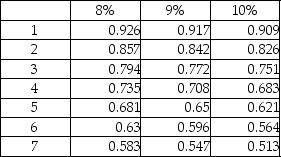John wins the lottery and has the following three payout options for after-tax prize money: 1. $150,000 per year at the end of each of the next six years
2. $300,000 (lump sum) now
3. $500,000 (lump sum) six years from now
The required rate of return is 9%. What is the present value if he selects the first option? Round to nearest whole dollar.
Present value of annuity of $1:  Present value of $1:
Present value of $1: 
Definitions:
Issue Price
The price at which securities, such as bonds or shares, are originally sold to the public or investors by the issuing entity.
Installment Note Payable
A debt instrument that requires a series of periodic payments to the lender over a specified period of time.
Interest Expense
The expenditure an entity incurs from borrowing funds during a certain period.
Notes Payable
Written agreements in which one party promises to pay another party a definite sum of money either on demand or at a specified future date.
Q6: Valuable Electronics uses a standard part in
Q15: Which of the following would not be
Q30: The AICPA offers a designation of Chartered
Q39: Centric Sail Makers manufacture sails for sailboats.
Q39: Delicious Food Products is famous for their
Q42: Which of the following two methods are
Q83: Gamma Company is considering an investment of
Q112: Managers who follow the management by exception
Q169: Managerial accounting develops reports that help internal
Q214: Use the appropriate letter(s)to indicate if the